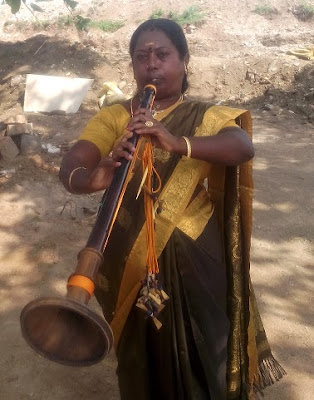Named as Arthanareeswara, Lord Shiva
reflects His left part of the body as His consort Parvathi - a symbol
for the deity's deep love for His wife and vice versa. As learned
from the devotional pieces of literature like Thevaram and
Thiruchengottu Puranam, Goddess
Parvathi had performed penance in popular holy places like Kedarnath,
Kasi, Kanchi and Thiruvannamalai to obtain a boon to become
permanently a part of Her husband. And the people of the Kongu region
can take pride that the 'holiest' place, where Parvathi could, at
last, obtain the boon was Thiruchengode in the Namakkal district.
Mentioned
as ' Thirukodimaada Chengundrur' in various pieces of ancient Tamil
literature, the town is popular for its Arthanareeswarar Temple, a
hill shrine, which inspired many devotional poets to sing paeans on
it. Observing an incident from the great Tamil epic Silapathikaram,
Arumpatha Urayasiriar, a well-known commentator on the epic, pointed
out that its heroine Kannagi came to the hill Neduvel
Kundram, which is none other
than Thiruchengode, after setting Madurai on fire.
Linking
the Lord's relationship with Kongunadu, Arthanareeswarar
Kuravanji, another literary work
penned by the 17th
century Kongu woman poet Poongothai, mentions Shiva and Parvathi of
Thiruchengode as 'Kongar Desar' and 'Mohanangi' respectively.
Thiruchengode, which means 'a holy,
red, mountain peak' looks like a snake when viewed from the plains.
Therefore, it got its other names as 'Nagasalam', 'Nagagiri' and
'Uragagiri'. Celebrated Tamil
Bhakthi poet Arunagirinathar, known for his devotional poem
Thirupugazh, calls
Thiruchengode as 'Nagasalam' in his literary works Kanthar
Anuboothi and Kandhar
Alangaram.
However,
archeologists and historians opine that Thiruchengode was a tribal
hill shrine once, since the Naga Vazhipadu or
worshipping snakes had been a culture with ancient tribes. They
contend that even the carving of the 60 feet 'Aadhisedan' ( chief of
the serpents) on the hill shrine is nothing but the remnant of the
tribal culture.
The
temple at Thiruchengode, besides its popularity in such pieces of
literature, recently became a spot of cultural politics after noted
Tamil writer Perumal Murugan was hounded by Hindutva and caste
outfits, as he had said in his novel Madhorubhagan
that childless women of Thiruchengode once indulged in
consensual sex at the Arthanareeswarar Temple in order to get
conceived.
Nonetheless,
the prayer today to the Lord is “ Arthanareeswara, End this
Epidemic Called 'Caste'
Link to my article in The New Indian Express : http://epaper.newindianexpress.com/535696/The-New-Indian-Express-Coimbatore/05072015#page/2/1


